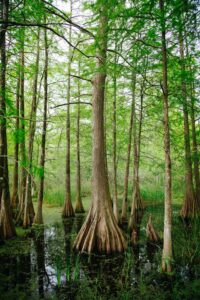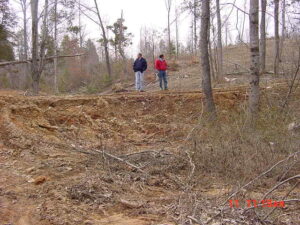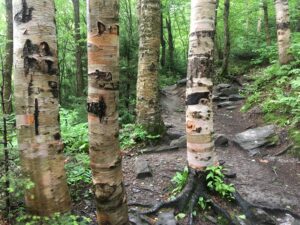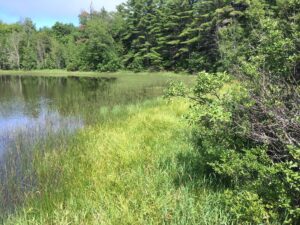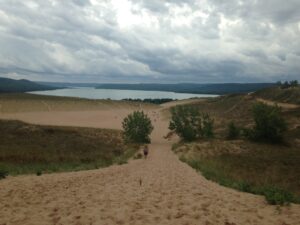Giving Back to Your Ecoregion
I live in Central Virginia, but also the Northern Piedmont/Piedmont Uplands ecoregion. As much as political boundaries, our ecoregions are responsible for the landscapes, livelihoods, cuisine, recreation, industries, cultures, and storytelling of the places where we live. As such, our ecoregions provide for us and sustain our communities.
If you wish to find your own ecoregion (and learn more about how ecoregions are defined), you can consult EPA’s Ecoregions website (drill down to the Level III and IV ecoregions for more specificity).
Throughout my life, I have had the opportunity to reside in or visit various ecoregions. This blog includes my own version of ecoregional storytelling for several of these, highlighting a unique characteristic from each region: its climate, soil, vegetation, and insects. I end with a notion that, in this season of giving, we can give something back to our own ecoregions.
Climate
In the 1980s, one of my jobs was based out of Nashville, TN, and I made somewhat frequent trips to Alabama and Mississippi, including in the “Southeastern Plains” ecoregion (known more colloquially as the Gulf Coast). Summertime there was an experience I would remember more clearly had my brain not been in the process of melting. However, I do remember that plants grew with exuberance, pecan trees grew in groves, and not to eat the little red peppers that locals offered me (trial by fire, so to speak).
This ecoregion and its soupy climate produces a vast diversity of ecosystems: pine savannahs, cypress-tupelo swamps, tidal marshes, dunes, seagrass meadows, and more. In 2020, the climate has been a real menace to parts of this ecoregion, with a dozen named storms and several hurricane landfalls.
Soil
When I lived in the Piedmont of North Carolina, a newcomer once asked why everyone’s pants cuffs were stained orange. Indeed, soil is one of the main identifiers of an ecoregion and the ecological history of the place, not to mention the laundry liability. The red clay of the Piedmont is an ecoregional manifestation of the bedrock (iron-rich), climate, and relatively stable conditions that allow soil to weather from the bedrock.
Whatever ecoregion you live in, you are probably stuck with the soil of that place. In Red Clay country, this may frustrate some gardeners and erosion control inspectors, but the soil also affords some opportunities. Many years ago, as a North Carolina resident hitchhiking and Alaska, I was picked up by a homesteader. Upon discovering my N.C. affiliation, he asked whether I was familiar with a string band called the The Red Clay Ramblers. Why, certainly, I allowed, as I had seen the Ramblers many times in concert. That night, I have Carolina red clay to thank for a warm meal and a place to sleep.
Vegetation
New Englanders in the Northeastern Highlands ecoregion are fairly sanctimonious about their ecoregion, and perhaps for good reason. The whole identity of the place is associated with a tree and the sweet syrup that the rest of us are willing to pay top dollar for just because it comes from that ecoregion. While I do enjoy maple syrup, I must admit that, being an outsider, the Paper Birch in the woodlands provides the keenest sense of being immersed in this ecoregion.
The fact that this ecoregion has an intimate relationship with its forests is reinforced by the fact that every little village and township seems to have a community-owned woodland, with the history of this relationship spanning several centuries.
Insects
Let’s face it, one of the distinguishing characteristics of some ecoregions is the insect life, including, somewhat notably, the Northern Lakes and Forests ecoregion. I generally am very tolerant of bugs, appreciate their expansive role in the functioning of an ecosystem, and even cohabitate with many types of them. However, some summer camping expeditions in Wisconsin and Michigan have exposed me (literally) to a place where the insect kingdom reigns with an iron stinger. It is no wonder that this ecoregion also had so many taverns, having been driven to such myself in the evening to escape swarming clouds of mosquitoes.
Of course, the insect life reflects the ecoregional quality of a myriad of lakes and rivers characteristic of its glaciated past. Few other ecoregions have camping, fishing, and outdoor recreation baked into the culture as this one. Some of my favorite stories by the late author, Jim Harrison, paint a vivid picture of the landscape and lifeways of the Upper Peninsula of Michigan, an iconic setting in this ecoregion.
My Home
I have been a resident of the Northern Piedmont/Piedmont Uplands ecoregion for most of my adult life. For most of us, our home ecoregion is the place where we feel, well, most at home. We greet the more familiar plants and animals as fond acquaintances, and express awe at the rarer or more ephemeral sightings. We feel a sense of belonging.
At time of year, I appreciate the creamy crowns of sycamore trees down by the river glowing in the late afternoon sun (which sets all too soon). I enjoy the cathedral-like quality of walking through a forest of tulip poplar and oak trees and the filigree of tree branches against the background hues of the setting sun. Yesterday, Garnett and I walked a section of the Appalachian Trail, tracing the path of a small watershed from its tippy top to the downstream confluence – that is a great experience.
In 2020, my ecoregion afforded me the opportunity of three seasons of gardening, with the square footage expanded as a COVID project. The okra alone demonstrated the most tenacious optimism of any plant I have ever grown. I take that as a lesson from the plant world, and likely a resolution for 2021.
Give Something Back to Your Ecoregion
As Braiding Sweetgrass author, Robin Wall Kimmerer, notes, we receive many gifts from our ecoregions, and can give back in numerous ways. As I write this on the Winter Solstice, I realize one way is to acknowledge our particular ecoregion – whether it be its climate, soil, vegetation, insects, or other inhabitants or qualities – and express gratitude in this season of pausing and reflection.
I wish you all a season of such gratitude and many opportunities to both give to and receive from your ecoregion.
David J. Hirschman, [email protected]

